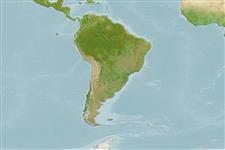Octocorallia |
Malacalcyonacea |
Alcyoniidae
Environment: milieu / climate zone / depth range / distribution range
Ecology
Sessile; depth range 15 - 35 m (Ref. 87801). Temperate; 48°S - 51°S (Ref. 87801)
Southeast Pacific: Possibly endemic to Chile.
Length at first maturity / Size / Weight / Age
Maturity: Lm ? range ? - ? cm
This species is found on steep or vertical rocky areas with biogenic substrates such as dead gorgonians or polychaete tubes at depths of 15 to 35 m. They are also seen in areas with moderate to strong currents and relatively low sedimentation (Ref. 87801).
Life cycle and mating behavior
Maturity | Reproduction | Spawning | Eggs | Fecundity | Larvae
Members of the class Anthozoa are either gonochoric or hermaphroditic. Mature gametes are shed into the coelenteron and spawned through the mouth. Life cycle: The zygote develops into a planktonic planula larva. Metamorphosis begins with early morphogenesis of tentacles, septa and pharynx before larval settlement on the aboral end.
Häussermann, V. and G. Försterra 2009 Marine benthic fauna of Chilean Patagonia. Santiago, Nature in Focus. 1000 p. (Ref. 87801)
IUCN Red List Status
(Ref. 130435: Version 2025-1)
CITES status (Ref. 108899)
Not Evaluated
Not Evaluated
Threat to humans
Harmless
Human uses
| FishSource |
Tools
More information
Trophic EcologyFood items (preys)
Diet composition
Food consumption
Predators
Population dynamicsGrowth
Max. ages / sizes
Length-weight rel.
Length-length rel.
Length-frequencies
Mass conversion
Abundance
Life cycleReproductionMaturityFecunditySpawningEggsEgg developmentLarvae PhysiologyOxygen consumption
Human RelatedStamps, coins, misc.
Internet sources
Estimates based on models
Preferred temperature
(Ref.
115969): 8.7 - 12.2, mean 10.9 (based on 16 cells).
